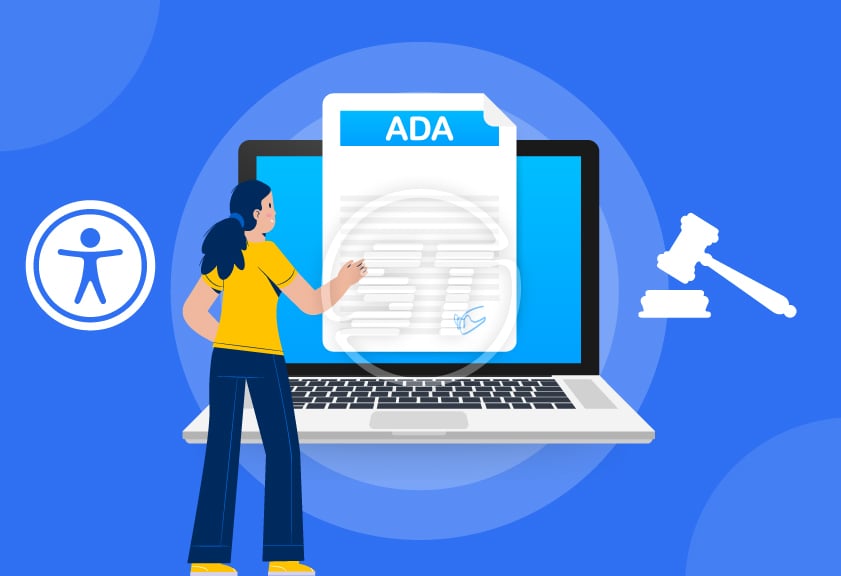Imagine opening mail inbox to find a formal letter alleging that a business website violates the ADA requirements. The mail accuses the business of discriminating against people with disabilities because its site isn’t accessible and demands swift action or threatens legal consequences.
Thousands of businesses – big and small – receive ADA web accessibility demand letters every year. It’s alarming and businesses ought to take the required steps to evade such situations. Also, with the right steps, it is possible to respond appropriately to these demand letters. And correct and timely measures help minimize legal risks and turn a potential crisis into an opportunity for improvement.
This article has a step-by-step guide to navigating an ADA demand letter with confidence.
Demand letters need careful consideration!
First things first: don’t ignore the demand letter.
ADA demand letters are serious legal documents, not spam. They typically allege that a website is inaccessible to people with disabilities (often due to screen reader or keyboard navigation issues), violating the ADA or similar state laws.
But wait, don’t panic before analyzing it. Not every letter results in a lawsuit. Many are part of a broader push by advocacy groups or law firms to drive compliance.
Note to remember: A calm, informed response can prevent escalation.
Notify legal counsel immediately
Get in touch with the legal team or hire an attorney with ADA website compliance experience. Accessibility lawsuits can be complex, and laws vary by state (especially with additional rules under the Unruh Act in California or New York’s state laws).
An attorney will:
- Review the legitimacy of the claim.
- Advise on risk exposure.
- Help craft a response to the claimant’s attorney.
Note: Some demand letters may be opportunistic, or template based. A lawyer can identify those and respond strategically.
Conduct an accessibility audit
Even if a business is unsure about the validity of the letter, now is the time to audit the website for accessibility issues. Use both automated tools (like Accessibility Checker, WAVE or Lighthouse) and manual accessibility testing (especially with screen readers and keyboard-only navigation).
Look for common barriers like:
- Missing alt text on images.
- Poor color contrast.
- Unlabelled form fields.
- Inaccessible menus or buttons.
Businesses can also engage a professional accessibility consultant or firm to provide a more thorough WCAG 2.1/2.2 audit.
Create a website accessibility remediation plan
Once accessibility gaps are identified, develop a clear action plan to fix them. This plan should include:
- Specific issues to be addressed.
- A timeline for resolution.
- The tools and teams involved.
- Ongoing website accessibility monitoring and training and practices.
A good accessibility remediation plan helps both, the claimant and the legal counsel that is working for organization, by fixing the issues and preventing future barriers.
Pro tip: Some legal settlements require a public accessibility statement and regular audits – consider incorporating this into a plan proactively.
Respond formally and professionally
With an attorney’s help, respond to the demand letter. The response may include:
- Acknowledgment of the complaint.
- Organization’s commitment to accessibility.
- A summary of remediation efforts.
- A proposal to resolve the matter without litigation (if appropriate).
In many cases, a professional and proactive response – especially when backed by an audit and timeline – can prevent a lawsuit from being filed.
Implement the accessibility fixes
Now comes the hard work: actually, fixing the website. Depending on the issues and the complexity of the site, this may take a few weeks or several months.
Make sure to:
- Work with developers/agencies trained in accessible coding practices.
- Include accessibility in the web design.
- Test all changes with both tools and real users with disabilities, if possible.
Once fixes are made, document everything – before-and-after screenshots, code changes, audit results, and internal emails. These can be valuable if the issue escalates or comes up again.
Stay compliant moving forward
Accessibility isn’t a one-and-done project – it’s an ongoing commitment. To avoid future demand letters or lawsuits:
- Include accessibility checks in every update or redesign.
- Train the teams regularly.
- Publish an accessibility statement on the website.
- Schedule annual audits to stay compliant with evolving standards.
Think of accessibility like security, proactive measures today save money and stress.
Wrapping up
Receiving an ADA web accessibility demand letter can feel overwhelming – but it doesn’t have to derail a business. By taking swift, smart, and strategic action, businesses can protect a brand, serve their users better, and build a more inclusive digital experience.
Accessibility is more than a legal checkbox – it’s a reflection of an organization’s values and commitment to equity in the digital age.
If your business has received an ADA web accessibility demand letter, it’s important to act promptly and effectively. We offer comprehensive web accessibility solutions including audit, consulting, remediation, PDF document accessibility remediation, ACR / VPAT, training, ongoing monitoring, and support to help you identify compliance gaps and implement necessary fixes. Reach out [email protected] to take proactive step toward creating an inclusive, compliant digital experience for all users.


